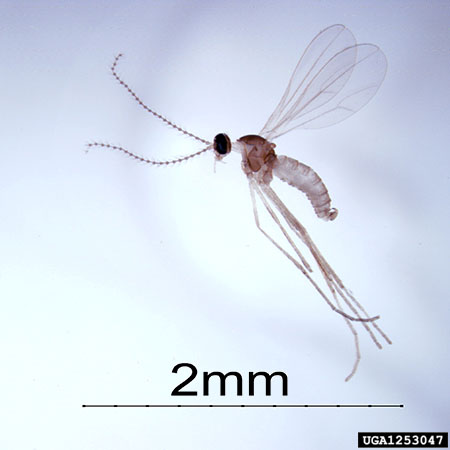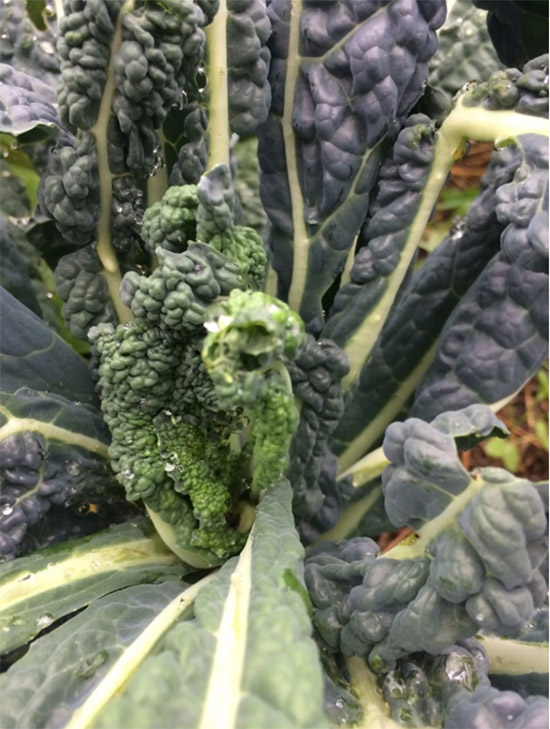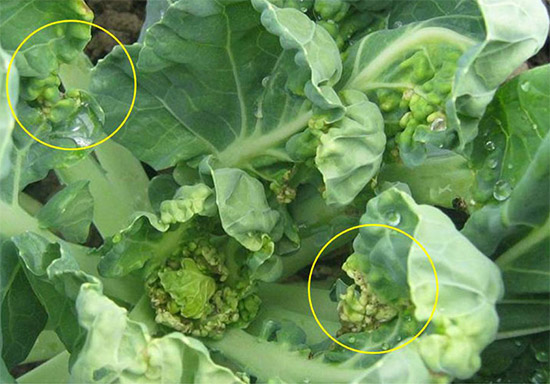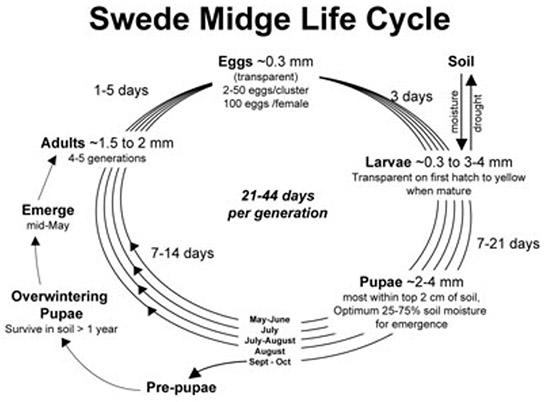Issue 9, June 25, 2018
Swede Midge a Threat to Illinois Crucifers
The swede midge was confirmed for the first time in Illinois last July in a homeowner garden in Cook County. This insect is a serious pest of cruciferous plants such as cabbage, cauliflower, and broccoli.
We know very little about its potential distribution in Illinois at this point. Swede midge is widespread in the northeastern U.S. An invasive pest, it is native to Europe and Southeast Asia.

Figure 1. Swede midge adult fly. Photo by: Susan Ellis, USDA APHIS PPQ, Bugwood.org
While the greatest damage caused by the swede midge has been on broccoli, there are many potential cruciferous host plants in the Brassicaceae family such as broccoli, Chinese broccoli, Brussels sprouts, cauliflower, Chinese cabbage, and other Asian greens. Non-cultivated plants in this family may also be infested (wild mustard, shepherd's purse, wild radish, field pennycress, and yellow rocket).
It is important to look for larvae on or within the plant tissue feeding near the growing points. Larvae are generally found feeding in groups. They are transparent but become increasingly yellow as they age. Full size larvae are 2-4 mm in length. The larval stage is the only life stage that can damage the plant.
As they feed, larvae produce a secretion that breaks down the plant cell wall allowing the larvae to feed on the liquid contents. This changes the physiology of the plant and results in the formation of swollen, distorted and twisted tissue.
Feeding caused by the swede midge includes leaf puckering, scarring, galls, or other deformities. There are lots of different causes to symptoms such as these, making it difficult to distinguish not only from other related insect species (midges, gnats, and mosquitoes), but also other factors such as mechanical injury from cultivation, herbicide injury, genetic variation of the plant, and heat or cold stress.

Swede midge damage on cauliflower, causing small head and leaf puckering. (University of Minnesota).

Swede midge damage on kale – note twisted and puckering leaves. (University of Minnesota).

Swede midge damage on broccoli – note puckering (Cornell University).
Breakdown of swede midge damage on crops (http://web.entomology.cornell.edu/shelton/swede-midge/damagecrops.html):
- Puckered and crinkled leaves
- Leaf puckering can give a drawstring effect
- Swollen tissue of leaf petioles/bases
- Brown scarring at growing point
- Distorted growing points including twisting
- Presence of secondary bacterial rots
Swede midge damage increases:
- as the number of larvae feeding per plant increases
- the earlier in development that the plant is infested (i.e. damage pre head formation is more damaging because it could result in blind heads)
- later in the season as the population builds
- in sheltered areas near hedgerows, buildings, treelines, etc. where populations tend to build

Research from Canada indicates that swede midge adults will emerge continually from the end of May to the end of September. Adults will lay eggs in new growth of host plants and larvae will feed on plant tissue until they are ready to pupate. Because of the multiple, overlapping generations each year, there is a potential for swede midge activity throughout the growing season.
As mentioned above, we are uncertain if and where other swede midge populations may be in Illinois. Confirmation of Swede midge in new locations will require specimens of adult flies. Samples of infested plants with larvae can be held until flies emerge for identification or traps can be placed to capture adult flies in the growing field. The adult fly is very small, about 1-2 millimeters in length, and requires an experienced entomologist to differentiate them from other related midges.
If you believe you have swede midge present in your fields or gardens, we encourage you to follow the steps from Cornell (http://web.entomology.cornell.edu/shelton/swede-midge/monitoring.html) detailed on their Scouting for Swede Midge page. If you have questions or think you are dealing with swede midge, please contact Kelly Estes (kcook8@illinois.edu).
Great Resources for Swede Midge can be found at the Swede Midge Information Center for the U.S.
(http://web.entomology.cornell.edu/shelton/swede-midge/index.html) (Kelly Estes)
Author:
Kelly Estes